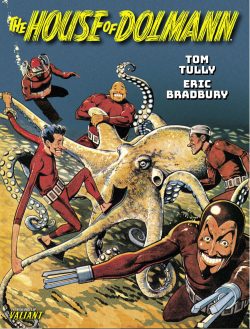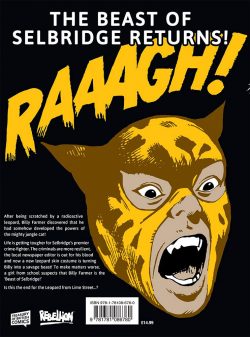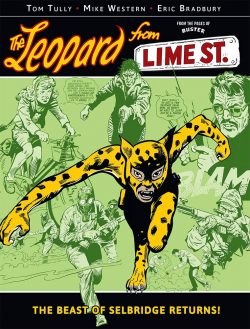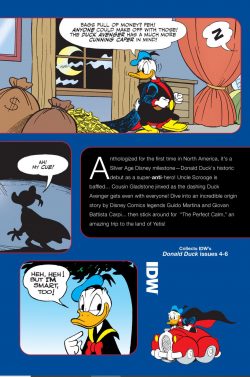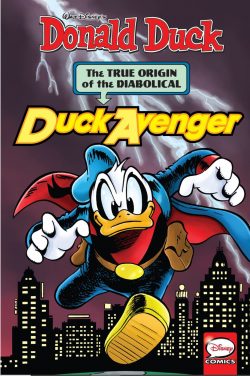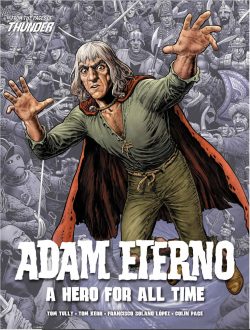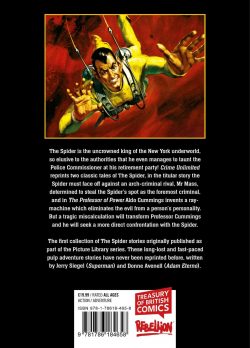
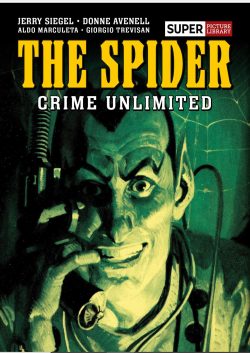
By Jerry Siegel, Donne Avenell, Aldo Marculeta, Giorgio Trevisan & various (Rebellion Studios)
ISBN: 978-1-78618-465-8 (HB/Digital)
Win’s Christmas Gift Recommendation: Bizarrely Bombastic Action Adventure… 8/10
Part of Rebellion’s Treasury of British Comics strand, The Spider: Crime Unlimited is a sublimely cool hardback collection celebrating an all-but forgotten sub-strand of the 1960s comics experience.
Until the 1980s, comics in the UK were based on an anthological model, offering variety of genre, theme and character on a weekly – or sometimes fortnightly – basis. Humorous periodicals like DC Thomson’s The Beano were leavened by thrillers like Billy the Cat or General Jumbo and adventure papers like Amalgamated Press/Fleetway’s Lion or Valiant always included gag strips such as The Nutts, Grimly Feendish, Mowser and a wealth of similar quick laugh treats. And yes, both rival companies had equivalents in those categories too…
They also produced Seasonal specials, hardcover Annuals and digest-sized anthology publications. DCT still publishes Commando Picture Library and used to have romance and science fiction titles such as Starblazer, matched by their London competitors with titles like Super Picture Library, War Picture Library, Air Ace Picture Library and Action Picture Library. These were half-sized, 64 page monochrome booklets with glossy soft-paper covers, but between 1967 and 1968 – at the height of the sixties Spy and Superhero booms – were supplemented by a deluxe, card-cover, 132 page version – The Fleetway Super Library.
As well as the always-popular war option of “Front Line” (starring by turn Maddock’s Marauders or Top-Sergeant Ironside), this line offered a “Secret Agent Series” – alternating cool spy operatives Johnny Nero and Barracuda – and the “Stupendous” (formerly and briefly “Fantastic”) series: delivering lengthy complete sagas starring either The Steel Claw or The Spider. These extra adventures came twice a month and ran 13 tales for each, and this spiffy hardback tome (245x177mm) re-presents the second and fourth releases, both starring the eerie webspinning master of crime…
British comics had a strange and extended love affair with what can only be described as “unconventional” (for which feel free to substitute “creepy”) heroes. So many of the stars and potential role models of our serials and strips were just plain “off”: self-righteous, moody voyeurs-turned vigilantes like Jason Hyde, sinister masterminds like The Dwarf, deranged geniuses like Eric Dolmann, jingoistic, racist supermen like Captain Hurricane and more often than not reformed criminals or menaces like Charlie Peace, The Steel Claw or The Spider…
…And don’t get me started on our legion of lethally anarchic comedy icons or that our most successful symbol of justice is an Eagle-bedecked, anonymously-helmeted, jack-booted poster boy for a fascist state. Perhaps that explains why these days we can’t even imagine or envision what a proper leader looks like and keep on electing clowns, crooks and obliviously blinkered over-privileged simpletons…
All joking aside, British comics are unlike any other kind and simply have to be seen to be believed and enjoyed. One of the most revered stars of the medium has finally begun to be collected in various archival editions, and perfectly encapsulates our odd relationship with heroism, villainy and particularly the murky grey area bridging them…
Mystery criminal genius and eventual superhero The Spider launched in peerless weekly anthology Lion with the June 26th 1965 issue. He would reign supreme until April 26th 1969, and periodically return in reprint form (in Vulcan) and occasionally new stories ever since.
As first introduced by Ted Cowan (Ginger Nutt, Paddy Payne, Adam Eterno, Robot Archie) & Reg Bunn (Robin Hood, Buck Jones, Captain Kid, Clip McCord), the moody malcontent is an enigmatic super-scientist whose goal is to be acclaimed the greatest criminal of all time. The flamboyantly wicked narcissist began his public career by recruiting crime specialists: safecracker Roy Ordini and genteelly evil inventor Professor Pelham before attempting a massive gem-theft from America’s greatest city. He was foiled by cruel luck and resolute cops Gilmore and Trask: crack detectives cursed with the task of capturing the arachnid arch-villain.
Cowan scripted the first two serialised sagas before handing over to comics royalty: Jerry Siegel (Superman, Superboy, The Spectre, Doctor Occult, Slam Bradley, Funnyman, The Mighty Crusaders, Starling), who was forced to look elsewhere for work after an infamous dispute with DC Comics over the rights to the Man of Steel.
Here his unique approach and astounding imagination results in a truly bizarre outing for Aldo Marculeta – who draws like Massimo Bellardinelli – to illustrate in 2 panels per page as Super Picture Library #2 heralds the menace of ‘The Professor of Power’…
It begins as The Spider crashes a fancy party to mock retiring Police Chief Brady whilst abusively reminding his minions who is boss, but has unexpected repercussions as outraged scientist Aldo Cummings creates a process to counteract the evil of such villainy by removing wickedness from living beings. Sadly, his ray machine malfunctions and utterly alters his own personality whilst also bestowing other arcane gifts…
Although completely evil now, the shapeshifter is still obsessed with The Spider and sets out to humiliate and destroy him through a campaign of terror that sees his opponent beaten and jailed whilst the Professor disrupts global peace and even sacrifices humanity to alien body snatchers from an extradimensional realm. With human beings inhabited by the evil entitoids, the maniac deems his duels with the webspinner over, but he has underestimated the cunning and resolve of his foe, who finds himself in the strange position of being Earth’s saviour…
Following is ‘Crime Unlimited’ from SPL #4, illustrated by Italian multinational star turn Giorgio Trevisan (Cherry Brandy, War Picture Library, Battler Britton, HMS Outcast, Trelawney of the Guards, The Flying Fortress, Bob Pepper, Silver Arrow, Ken Parker, Sherlock Holmes and so much more) with a terse, gritty script from British legend Donne Avenell.
Staring his career before WWII, Avenell cut his teeth on many British comics icons like Radio Fun, War Picture Library, The Phantom Viking, Adam Eterno and Dr. Mesmer’s Revenge, major international features line Nigeria’s Powerman, Buffalo Bill, The Phantom and assorted Disney strips. He was equally at home with newspaper strips such as Tiffany Jones, Axa and Eartha novels and TV screenwriting on shows like The Saint). Here he pits the swaggering arrogant super-criminal against a brilliant and ruthless inventor who applies Henry Ford’s business practices to organised crime: using vast engineering talents and mass-production techniques with the view to getting rich by stealing The Spider’s title as Emperor of Crime…
Mr. Mass begins with a wealth magnet to snatch the proceeds of a Florida heist right out of the Spider’s bony fingers, builds an unstoppable mole machine and ultimately unleashes an army of plundering doppelganger thanks to his Mass-Replicator, with neither Pelham & Ordini nor Trask & Gilmore able to slow the warring masterminds down.
Implacable foes conducting industrial warfare, the duelling geniuses hurtle towards a spectacular final accounting after Mass reduces an entire city to mental infancy, but fails to stop his webspinning nemesis tracking him down to a catastrophic clash in an automated factory…
These retro/camp masterpiece of arcane dialogue, insane devices and rollercoaster antics are augmented by Extras including original covers, biographies of the writers and ads for even more uncanny UK comics collections, both available and forthcoming…
This titanic tome reaffirms that the Emperor is back at last and should find a home in every kid’s heart and mind, no matter how young they might be, or threaten to remain. Batty, baroque and often simply bonkers, The Spider proves that although crime does not pay, it always provides a huge amount of white-knuckle fun…
© 1967 & 2022 Rebellion Publishing IP Ltd. All Rights Reserved.





